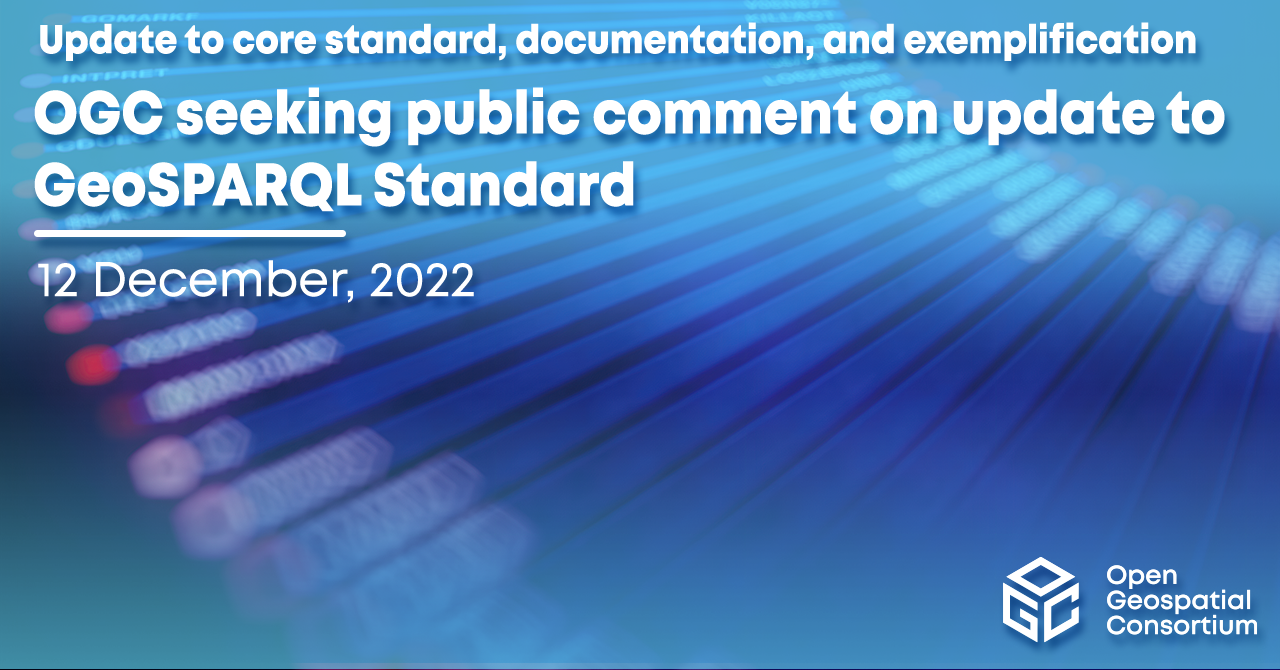Update improves core standard, documentation, and exemplification. Comments should be submitted via the method outlined on the GeoSPARQL v1.1 Standard’s public comment request page. Comments due 13 February, 2023.
12 December 2022: The Open Geospatial Consortium (OGC) is seeking public comment on the adoption of GeoSPARQL v1.1 as an OGC Standard. OGC GeoSPARQL extends W3C’s SPARQL to provide a geographic query language for RDF data.
Version 1.1 of GeoSPARQL extends the originally published standard in 2012 that is used for representation and querying of geospatial linked data for the Semantic Web in new ways.
SPARQL is one of several key technologies that enable the “Semantic Web” or “Web of data,” where data is published to the Web so that it can be accessed, shared, and reused across applications and users. In other words, in a manner aligned with the FAIR data principles (Findable, Accessible, Interoperable, and Reusable). SPARQL specifications provide languages and protocols to query and manipulate RDF graph content on the Web or in an RDF store.
Other technologies identified by the W3C Semantic Web Activity as being key to the Semantic Web include the Resource Description Framework (RDF) data model, which provides a directed, labeled graph data format for representing data on the Web, and the OWL 2 Web Ontology Language, which provides an ontology for the consistent naming and identification of data.
The OGC GeoSPARQL draft specification complements these technologies by providing a geographic query language for RDF data that contains a spatial component.
The OGC GeoSPARQL Standard comprises multiple parts, with the Standard defining:
-
A formal profile;
-
The Standard document;
-
A core RDF/OWL ontology for geographic information representation;
-
A set of SPARQL extension functions;
-
A Functions & Rules vocabulary, derived from the ontology;
-
A Simple Features geometry types vocabulary;
-
SHACL shapes for RDF data validation.
GeoSPARQL does not define a comprehensive vocabulary for representing spatial information. Instead GeoSPARQL defines a core set of classes, properties, and datatypes that can be used to construct query patterns. Many useful extensions to this vocabulary are possible, and the chairs of the OGC GeoSPARQL Standards Working Group intend for the Semantic Web and Geospatial communities to develop additional vocabularies for describing spatial information.
GeoSPARQL v1.1 adds the following changes to the existing v1.0 Standard:
Support for several now common geometry formats such as GeoJSON have been added as well as many simple non-topological functions, such as one to calculate area. A novel addition is support for Discrete Global Grid System geometry representations.
The GeoSPARQL ontology has been updated with Ontology properties for metric and non-metric measurements using properties and with classes to represent FeatureCollections and GeometryCollections are also new as well as. Also, a set of SHACL shapes allows to validation ofe GeoSPARQL 1.1 formatted graphs.
Many major updates to GeoSPARQL in this release though are not changes to the core standard but great improvements in the documentation and exemplification. Mappings to other models and query languages are also now included as well as data validators and support vocabularies, all of which are presented as a formal profile of multiple, related, resources with defined roles.
OGC Members interested in staying up to date on the progress of this standard, or contributing to its development, are encouraged to join the GeoSPARQL SWG via the OGC Portal.
The candidate GeoSPARQL v1.1 standard is available for review and comment on the OGC Portal. Comments should be submitted via the method outlined on the GeoSPARQL v1.1 Standard’s public comment request page. The period for comments ends 13 February, 2023.
About OGC
The Open Geospatial Consortium (OGC) is a collective problem-solving community of more than 550 experts representing industry, government, research and academia, collaborating to make geospatial (location) information and services FAIR – Findable, Accessible, Interoperable, and Reusable.
The global OGC Community engages in a mix of activities related to location-based technologies: developing consensus-based open standards and best-practices; collaborating on problem solving in agile innovation initiatives; participating in member meetings, events, and workshops; and more.
OGC’s unique standards development process moves at the pace of innovation, with constant input from technology forecasting, practical prototyping, real-world testing, and community engagement.
OGC bridges disparate sectors, domains, and technology trends, and encourages the cross-pollination of ideas between different communities of practice to improve decision-making at all levels. OGC is committed to creating an inclusive and sustainable future.
Visit ogc.org for more info on our work.
“
